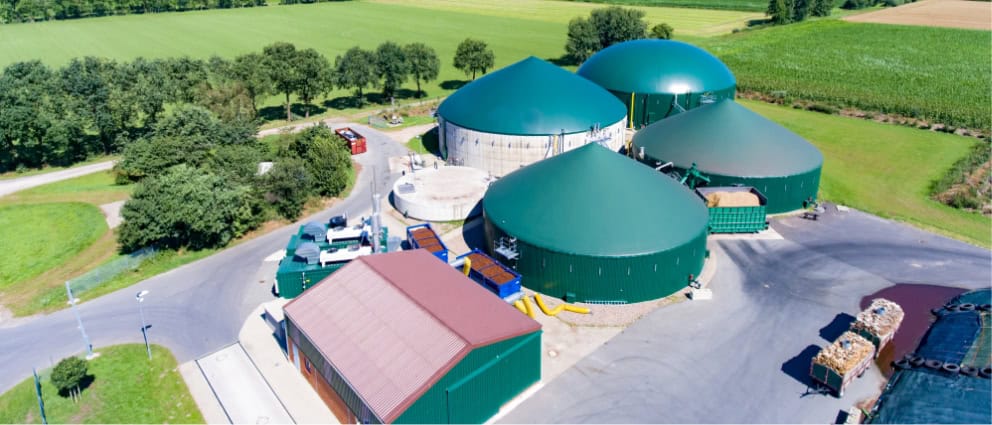In a time when sustainability and renewable energy sources are increasingly important, biogas plants have emerged as a promising solution. These facilities contribute to both having a cleaner environment and offering a sustainable source of energy.
What is biogas?
Biogas is a renewable source of energy that is produced from the decomposition of organic matter in the absence of oxygen. This organic matter can be of plant or animal origin, and comes from agricultural, food or industrial waste, as well as wastewater.
It is composed mainly of methane (CH4) and carbon dioxide (CO2), with small amounts of other gases, such as nitrogen (N2), hydrogen (H2) and hydrogen sulfide (H2S).
What are biogas plants?
Biogas plants are an innovative technology that is revolutionizing the way we produce energy. They use organic matter to produce methane gas, which is used as fuel to generate electricity and heat.
Biogas plants use all kinds of waste, including agricultural waste, food waste and wastewater. These plants use a process called anaerobic digestion to break down organic matter and produce methane gas. This matter is placed in a digester without oxygen, where bacteria break it down into methane gas and other products. The resulting gas is stored or sent to a generator, where it is converted into useful energy. The solid waste that remains can be used as organic fertilizer for agriculture.
Why are biogas plants important?
Biogas plants contribute to the production of renewable and clean energy, which can be used to generate electricity, heat or fuel. This helps to reduce the dependence on fossil fuels and greenhouse gas emissions.
In addition, they also take advantage of organic waste that would otherwise be wasted or pollute the environment. This allows for better waste management and reduced environmental impact of human activity.
These plants also generate a by-product called digestate, which is an organic fertilizer rich in nutrients. This fertilizer can be used to improve soil quality and agricultural fertility.
They are also important in the rural environment as they promote development and job creation by offering a profitable and ecological alternative for farms and livestock.
Biogas plants follow some basic steps to transform organic matter into biogas. First there is a pre-treatment stage of the substrates, which may include tasks such as screening, crushing or homogenization of them. Then the organic matter, mixed with water, is introduced into one or several digesters. Inside the digesters, due to the lack of oxygen, the matter decomposes, generating methane and carbon dioxide, mainly. A valve located on the outside allows the passage of biogas to a network of pipes. The pipeline is derived to storage systems or to generators and engines, which convert biogas into electricity or heat. The remaining matter is expelled from the plant to serve as organic fertilizer in the agricultural industry.
Advantages of biogas plants
Biogas plants offer a host of advantages that place them at the forefront of the quest for sustainable energy:
- Renewable energy source: Biogas is obtained from organic waste, making it a renewable energy source that can be produced on a constant basis.
- Waste management: These plants help to effectively manage organic waste, reducing the burden on landfills and methane emissions from decomposing waste.
- Carbon footprint reduction: The use of biogas reduces the release of methane, a potent greenhouse gas, into the atmosphere.
- Energy independence: Biogas production provides a decentralized source of energy, reducing dependence on traditional fossil fuels.
- Agricultural benefits: The digestate produced can enrich soil quality, improving agricultural productivity.
Disadvantages of biogas plants
Biogas plants are facilities that use organic waste to produce clean, renewable energy. However, they also present some disadvantages that must be taken into account. These are:
- They require a high initial investment: The cost of building and starting up a biogas plant can be very high, depending on the size, capacity and technology used.
- They can generate odors: If the anaerobic digestion process is not properly controlled, the biogas can contain hydrogen sulfide, a gas with a very strong and unpleasant odor, which can cause nuisance to neighbors and public health problems.
- Waste produced by biogas plants, such as digestate, must be treated to remove contaminants and used as agricultural fertilizer. Failure to do so may result in negative impacts on the environment and human health.
- They may depend on the availability and proximity of feedstocks: Biogas plants need a sufficient and constant amount of organic waste to feed the anaerobic digestion process. If they are not available, or if they are far from the plant, it can reduce the yield and increase the cost of transportation .
- They may face unfavorable competition with other energy sources: The price of biogas can vary according to supply and demand, and may not be competitive with other cheaper and more established energy sources, such as natural gas or coal.









